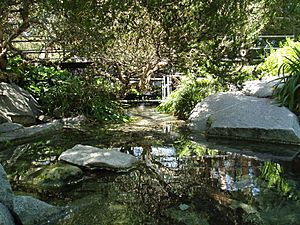Levi's Plaza facts for kids
Levi Strauss Plaza, also known as Levi Plaza, is a group of office buildings in San Francisco, California. It's located near North Beach and Telegraph Hill, right by The Embarcadero. This complex is the main home for Levi Strauss & Co., the famous company that makes blue jeans. It's often called San Francisco's "only true corporate campus" because it's a big, spread-out area with many buildings and green spaces.
History of Levi's Plaza
The land where Levi's Plaza now stands was once a wharf owned by Frederick Griffing. Over time, the land was built up, and the wharf, along with Frederick Griffing's ship, became buried. When workers started building Levi's Plaza, they actually found the old, buried ship!
The Levi Strauss Plaza was built by a company called Interland Development Corp. The main design work was done by Hellmuth, Obata and Kassabaum Inc. (HOK). Levi Strauss & Co. helped design the inside of the buildings. Construction started in 1979 and finished in 1981. The whole project cost a lot of money, with $110 million spent on the outside of the buildings and another $120 million on making the insides just right. Levi Strauss & Co. officially moved into the complex in 1981.
Around 1995, there were some discussions about how much rent Levi Strauss & Co. should pay. Even though there were talks about them possibly moving, the company never really thought about leaving San Francisco or Levi's Plaza. In 1998, Levi Strauss & Co. decided to renew their lease for a large part of the complex. They also announced they would spend millions of dollars to update the buildings, which were 17 years old at the time. These updates, which started in 1999, aimed to create a more open and team-friendly design.
In 2008, there was talk again about Levi Strauss & Co. possibly moving when their lease ended in 2012. However, in 2009, the company renewed its lease for another ten years, starting in 2013. This showed they planned to stay at Levi's Plaza for a long time.
Cool Design Features
Levi Strauss & Co. had a big say in how the plaza was designed. One of the designers, Bill Valentine, said they wanted it to feel like a "well-worn pair of blue jeans"—meaning relaxed and not too perfect. The company wanted the new complex to help all employees, no matter their job, mix and meet each other. In their old building, different levels of employees were on different floors and didn't often see each other.
At Levi's Plaza, there's a big open space called an atrium in one of the buildings. This space is designed so that everyone gets the same great view. There are also decks that connect the inside of the buildings with the outside areas, offering views of the city.
Keiko Yamagami, another designer, said the buildings feel like "small streets in a little town." Each part of the campus has its own "mini plaza," which she described as feeling like a cozy "den in a home." Different materials, like rubber tile flooring with colorful patterns, help guide people through the campus. The colors used in the flooring were inspired by "West Coast sunset colors."
The campus also has a gym and various kitchen areas, each with a different theme. The Levi Strauss cafeteria is designed to feel like a restaurant, not a typical company cafeteria. It has distinct areas with different colors and styles.
The design of Levi's Plaza also included an older building called the Italian Swiss Colony Building. The whole complex was planned to fit in well with the surrounding neighborhood. The red brick buildings were made to blend in with the historic warehouses nearby. The design also respected the residents of Telegraph Hill, which is a hill right behind Levi's Plaza.
Buildings and What's Inside
Levi's Plaza has several important buildings:
- Saddleman Building (1355 Sansome Street): This building has four floors and a lot of space. In the late 1990s, Levi Strauss & Co. moved its employees out of this building due to health concerns among some workers. Even though a study found the building was safe, employees felt worried, so the company moved them to other parts of the complex.
- Stern Building (1265 Battery Street): This building is located on the northeast side of the campus.
- Koshland Building
The complex also has a small shopping area with stores that serve both the people who live nearby and the employees. There's a large cafeteria for Levi Strauss employees that can serve many people.
A big part of Levi's Plaza, about 66%, is made up of open plazas and park land. Levi Plaza Park is a special part of the complex. It's described as a peaceful "Zen oasis" with willow trees, water, rocks, and winding paths. A famous landscape architect named Lawrence Halprin helped design this park. The park is divided into two parts by Battery Street. Community events are sometimes held in the park.
Levi's Plaza used to have a large building called the Ice House. Levi Strauss & Co. bought it in 1991 and later planned to redesign it.
Images for kids





